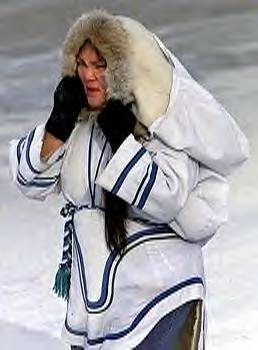|
|
Canku Ota |
|
|
(Many Paths) |
||
|
An Online Newsletter Celebrating Native America |
||
|
June 2, 2001 - Issue 37 |
||
|
|
||
|
Inuit Women Seek Parka Copyright |
||
 RANKIN INLET,
NUNAVUT - The national association of Inuit women is trying to prevent southern manufacturers from copying traditional
Inuit designs. Pauktuutit says it made big progress at a weekend conference to protect the amauti, or parka worn
by women. RANKIN INLET,
NUNAVUT - The national association of Inuit women is trying to prevent southern manufacturers from copying traditional
Inuit designs. Pauktuutit says it made big progress at a weekend conference to protect the amauti, or parka worn
by women.Delegates at the workshop want to make sure the amauti doesn't go the way of the kayak, copied and mass-marketed by southern companies without giving credit - or profit - to the Inuit who designed it. The group spent the weekend discussing the different laws that protect intellectual property such as copyright, trademark and industrial design. Tracy O'Hearn, the executive director of Pauktuutit, says those laws don't fit with the Inuit view of property. "They don't address the collective nature of the ownership and the protection are also time-limited," she says. O'Hearn says persuading the federal government to change the trademark act to protect the amauti won't be easy, but it's necessary to protect traditional knowledge. |
|
Arctic Region/Amauti |
|
|
|
|
||
|
|
||
| Canku Ota is a free Newsletter celebrating Native America, its traditions and accomplishments . We do not provide subscriber or visitor names to anyone. Some articles presented in Canku Ota may contain copyright material. We have received appropriate permissions for republishing any articles. Material appearing here is distributed without profit or monetary gain to those who have expressed an interest. This is in accordance with Title 17 U.S.C. section 107. | ||
|
Canku Ota is a copyright © 2000, 2001 of Vicki Lockard and Paul Barry. |
||
|
|
|
|
|
The "Canku Ota - A Newsletter Celebrating Native America" web site and its design is the |
||
|
Copyright © 1999, 2000, 2001 of Paul C. Barry. |
||
|
All Rights Reserved. |
